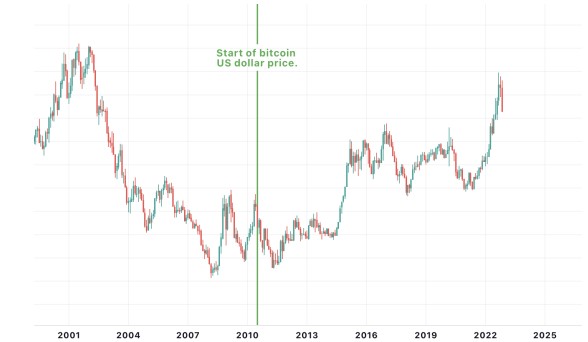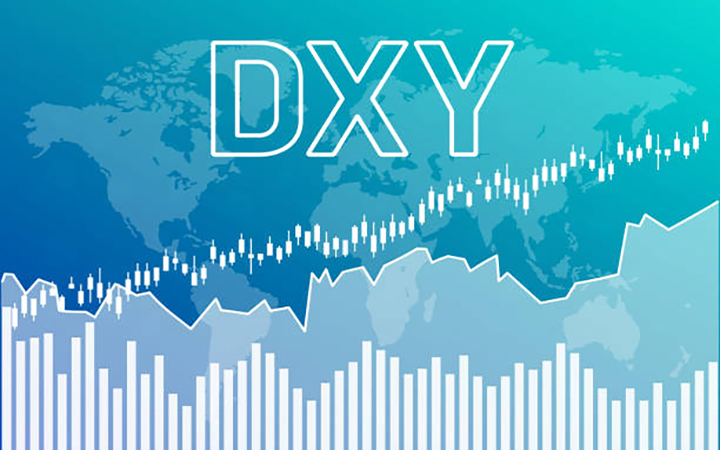At present times (2022), the cryptocurrency market is strongly dependent on the US dollar. It will remain so until the industry matures a fully independent anchor to the real world.
The US dollar has a universal role as a reserve and reference; even in crypto, as demonstrable by the huge capitalization of stablecoins pegged to USD. Most importantly, bitcoin, the lead cryptocurrency, is first priced in US dollars.
The DXY, also known as USDX or DX, is a measure of the relative strength of the US dollar in relation to a set of major fiat currencies. This index is being used by traders as a benchmark to derive insights about the US dollar condition in the global economy.
Because of the breadth of the US dollar impact, and the close relationship with crypto, the DXY appears to be a great instrument to rationalize the influence of the US dollar on the pricing of cryptocurrencies in a short to medium-term window.
The inevitable relationship between crypto and the US dollar
Here are some reasons why a strong dollar would impact the cryptocurrency market, and why it is important to keep an eye on the DXY to track its relative strength.
The US dollar connects crypto to the real world
Currently, the principal driving force of cryptocurrencies is the trust in it as a solid technology and form of money, but the real reason behind their trading volume is speculation, mostly happening for US dollar wealth.
Essentially, the US dollar represents the main bridge between cryptocurrencies and the real world. As for now, there is not enough application to say that crypto has an active role in our society, in order to isolate it from its dependency on the US dollar.
The only independent physical connection that is truly significant is the mining structure of bitcoin; anyway, it is still not enough to surpass the abstract motive (trust) and connect it to the real world better than the US dollar does.
The largest chunk of money engaging with cryptocurrency is mere speculation. Most people are more interested in their USD than their BTC wealth. There are very few traders who set up their trading to accumulate BTC rather than US dollars.
This is also one of the reasons why stablecoins have so much market capitalization; they are used as a quicker and less expensive means of accumulating capital in USD-corresponding units without having to convert it into real dollars and incur taxes. At present times, stablecoins embody all the risks they inspire.
Hence, tracking the US dollar strength would be useful to forecast eventual tendencies by the market participants to convert wealth into the preferred reserve.
The US dollar is the global reserve currency
Cryptocurrencies can be deeply affected by macroeconomics, therefore by things like inflation and interest rates. A global reserve currency plays an essential role in this context.
All the reasons we may come up with when we try to figure out how crypto and dollars are related, derive ultimately from the role of the US dollar as the global reserve currency.
What is a global reserve currency?
A global reserve currency is a preferred currency by most central banks and monetary authorities, as well as businesses and individuals, to store wealth in significant quantities.
The global reserve currency typically is stable and liquid enough to be used in most international exchanges and global trading activity as a whole. When a country’s currency is referred to as a reserve currency, the reliability in that country’s economy is at high standards. When its currency is referred to as the global reserve, the country is most likely considered the strongest
economy in the world.
Establishing a currency as the global reserve gives a huge boost to the native country’s economy: this is exactly what happened after the Bretton Woods Agreement in 1944. At the time, the US dollar was a second place preferred reserve, but the agreement fueled the decisive push to make the United States the strongest economy, and thenceforth the globe quickly adopted the US dollar as the world’s currency.
Nowadays, the global economy is strictly constrained to the US dollar, since it accounts for most of the trading activity. Nearly 40% of all the debt in the world is issued in US dollars.
The role of the US dollar as a global reserve currency is ultimately the reason why it is being used to price bitcoin, and thus to give a universally recognizable price to all other cryptocurrencies.
This makes it so that the US dollar is the principal quote currency in the crypto industry, therefore establishing an underlying inverse correlation between the US dollar and cryptocurrencies.
US dollar gaining strength against BTC and altcoins
Based on the underlying inverse correlation, if the USD gains strength, every asset priced against it weakens. BTC is by far the main crypto asset. When the US dollar gets stronger, BTC is supposed to lose ground against it. On the contrary, when the US dollar gets weaker, BTC gains ground.
This is a fixed principle, but it is just the basic underlying relationship. Many other aspects influence the price of an asset.
While the inverse symmetry exists, independent factors such as the individual strength of bitcoin, or major related happenings, divert the observable results. For example, BTC may gain strength even though the US dollar is doing as well.
What about altcoins?
The principle that ties bitcoin to the US dollar is the same that ties altcoins to BTC. Altcoins are related to the US dollar indirectly: specifically, through BTC.
BTC is not only the king: it is the bridge that connects the evaluations of every altcoin to the US dollar. The price of most altcoins is first established in BTC, then in US dollars.
Their dollar price is typically their BTC price converted to USD. It is safe to say that bitcoin influences all cryptocurrencies, and in general, the crypto industry.
Therefore, as a strengthening US dollar would decrease the USD price of bitcoin, a strengthening bitcoin would decrease the BTC price of altcoins. A strong US dollar would have negative effects on the price of both BTC and altcoins.
If you would like to deepen the BTC price of altcoins and why bitcoin is considered the “king”, check out this article.
We can then use bitcoin as a benchmark to understand the impact of the US Dollar’s strength on altcoins and the crypto market as a whole.
Important note
Let’s remember though, that an asset may have independent factors acting on its price. The inverse correlation between the US dollar strength and the price of cryptocurrencies is not isolated in the real world. Bitcoin may move independently, regardless of USD influence,
increasing or decreasing its price from its own productivity and demand. In the same way, altcoins may move independently, regardless of BTC, thus, any USD influence.
The multitude of aspects that drive growth or decay superimpose on their basic inverse relationship, thereby “hiding” it as more independent factors come into play. It could then be difficult to identify the impact of the US dollar’s strength on bitcoin when it is submerged under a sea of variables operating on the price of bitcoin, then on other cryptocurrencies.
When is the correlation between BTC and DXY more noticeable?
The correlation between BTC and DXY is most evident when the intensity of a dollar strength movement surpasses that of other factors. In other words, when it is high enough to emerge from the set of other influential factors. This mostly happens in short to medium-term windows.
As we go in the long-term, the set of independent factors tends to overcast the impact of the US dollar’s strength. If we consider more time, more things are at play that contribute to the price outside the inverse correlation to USD. The closer our perception of the market is to “now”, the more evident the underlying relationship.
If we would compare the long-term situation of bitcoin, the independent growth is too dominant as an influence on its price to detect any impact of the US dollar’s strength. As a matter of fact, the price history starting from 2010 (the start of bitcoin USD price) of both BTC and DXY displays a positive trend.

This indicates that the strengthening of the US dollar on bitcoin’s price has had a negligible impact in the long term. The same would be valid for any altcoins with strong enough independent growth.
On the other hand, major movements of the DXY in the short-term and possibly some medium-term cases can reflect (inversely) on cryptocurrencies. Generally, the stronger the intensity of a US dollar movement, the more it is visible through time, unless the intensity of the set of other factors strengthen as well.
In conclusion, the DXY would be more useful to traders that operate in small timeframes, as the inverse correlation tends to lose significance in the long term.
Why a crypto trader should look at the DXY
A rising DXY suggests an increasing interest to store wealth in US dollars. If the global reserve currency is preferred, it becomes stronger than the assets and currencies priced against it.
Apart from crypto maximalists, the vast majority of crypto investors and traders tend to run into the US dollar as soon as the global economy, or the bitcoin cycle, shows a bear market tendency. The DXY can then be used to rationalize market sentiment and forecast the psychological tendencies of the market participants in the short to medium term.
Furthermore, the very thing of pricing bitcoin in US dollars makes it so that there is an underlying inverse correlation between them. The DXY then provides a piece of ulterior information, that is the relative strength of the dollar itself: this would help in better defining the causes of bitcoin’s short to medium-term depreciation, which may not necessarily derive from a loss in intrinsic value, but instead the strengthening of the US dollar.
The USD price of bitcoin, and thus of the altcoins, do not represent their intrinsic value. A crypto trader should look at the DXY not as a support to evaluate cryptocurrencies intrinsically but concerning their US dollar quotation. Supply and demand do not always reflect the intrinsic value of a given asset.
True value has to be searched in the asset properties as an entity; in the case of bitcoin, intrinsic value may be represented by things like the hash rate, which is the total effort in producing bitcoin, which also suggests relative interest and real-world connections.
In conclusion
There is a basic inverse correlation between the global reserve currency (USD) and cryptocurrencies. However, other factors, such as the individual productivity and demand of a crypto, tend to “overcast” the magnitude of impact (that the strength of the global reserve currency has directly on the price) the more time is considered in the frame of reference.
The DXY is then an effective instrument to monitor the influence of the US dollar’s strength on cryptocurrencies in the short to medium term. A cryptocurrency trader should keep the US dollar index on the radar to improve his decision-making and enter the market with a wiser perspective.
Everything described in this article comes from the original research and opinions of the author and has the sole purpose of being informative and providing general information. The author has no intention of providing any financial advice, legal advice, or tax advice. The use you make of the information in this article is your sole responsibility. Do not rely on this article to make investment decisions. Seek professional help before making any such decision. The author of this article does not take any responsibility for loss or damage of any nature.
